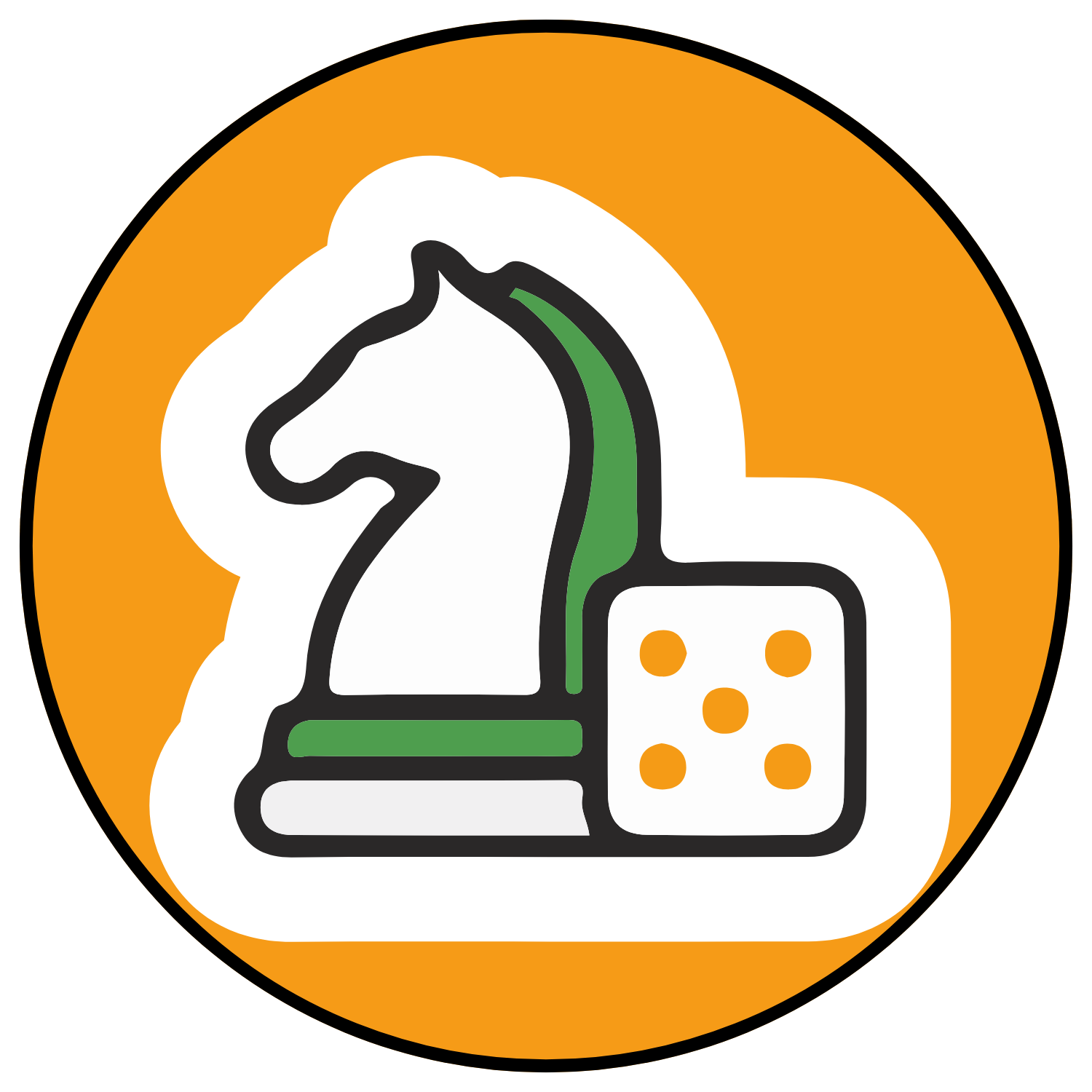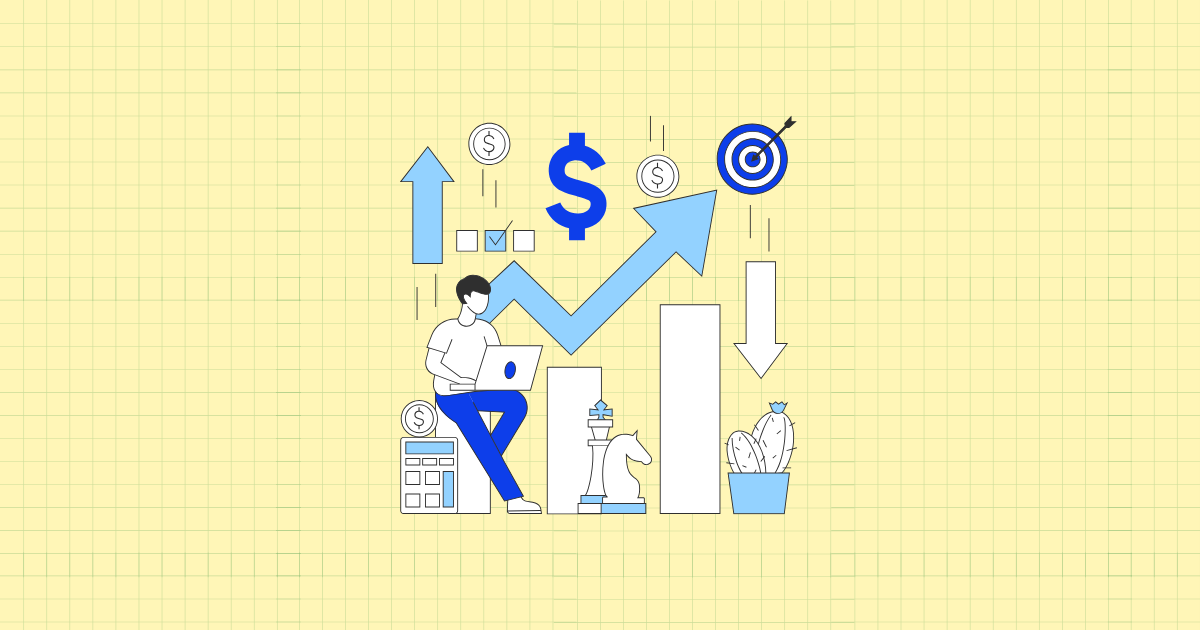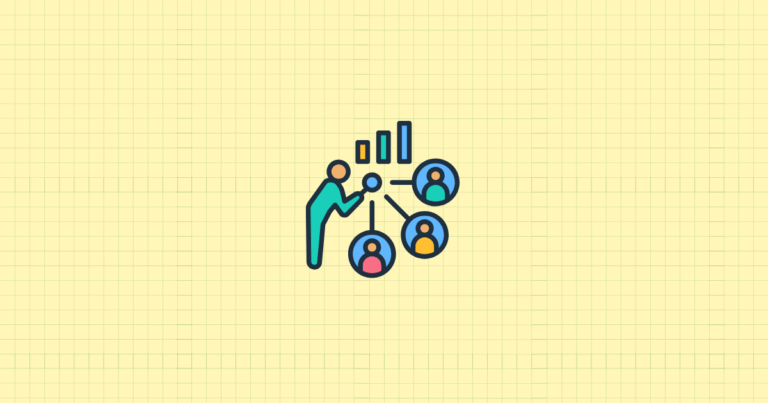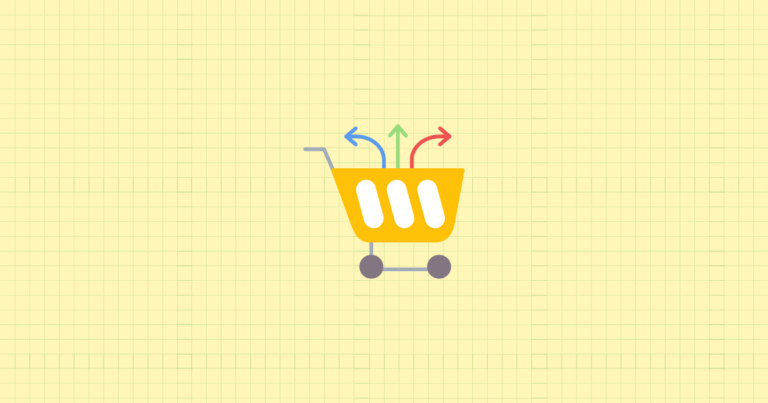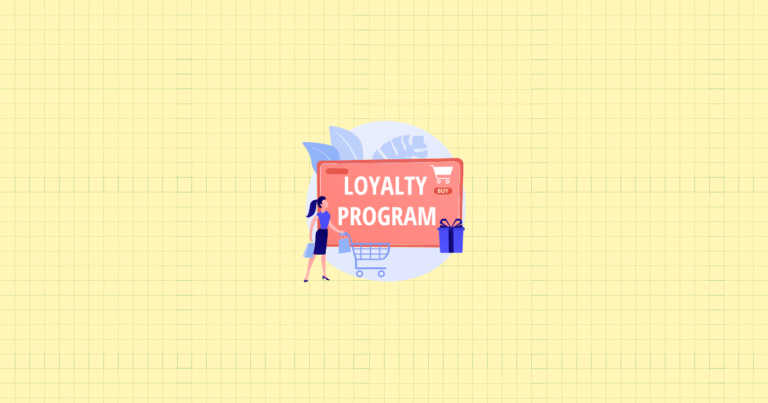Imagine walking into a store and finding the perfect item—exactly what you’ve been looking for—only to discover there’s just one left. Your heart beats a little faster. You check the price tag one more time. Suddenly, that “I’ll think about it” mentality vanishes. This instinctive response isn’t random—it’s hardwired into our brains. And as a Shopify store owner, understanding this psychology is your secret weapon for boosting conversions.
The Science Behind Consumer Decision-Making
We humans are fascinating creatures. Despite our best intentions to make rational decisions, we’re deeply influenced by emotional triggers—none more powerful than the Fear of Missing Out (FOMO). This psychological phenomenon explains why limited-time offers can transform browsers into buyers almost instantly.
FOMO isn’t just marketing jargon; it’s backed by cognitive science. When shoppers perceive limited availability, their brains activate the same regions associated with actual physical pain. Studies show that the mere suggestion of scarcity can increase a product’s perceived value by up to 26%. Think about that—same product, same price, but suddenly more desirable simply because it might not be available tomorrow.
But FOMO does more than just create desire. It actually short-circuits our normal decision-making process. Without urgency, customers follow a meandering path:
- Discover product
- Research alternatives
- Compare prices
- Read reviews
- Consider purchase
- Potentially abandon cart
With effective urgency triggers, this path dramatically shortens. The fear of missing out creates an emotional override that pushes customers to act now rather than later.
This explains why cart abandonment—a challenge facing every Shopify store owner—is so prevalent. A staggering 42.5% of customers who add products to their cart are thinking “I’ll buy it later.” But without urgency, “later” often becomes “never.” They leave, get distracted, find alternatives, or simply forget. Each abandoned cart represents revenue slipping through your fingers.
Urgency is your antidote to purchase procrastination. By creating authentic time pressure, you’re not manipulating customers—you’re helping them overcome decision paralysis and giving them a reason to act on desires they already have.
Key Components of Effective Urgency Tactics
Not all urgency tactics are created equal. The most effective strategies fall into two main categories: scarcity-based and time-based urgency.
Scarcity-based urgency leverages limited availability. When your store shows “Only 3 left in stock,” it creates immediate tension in the shopper’s mind. They must decide quickly or risk missing out entirely. This approach works exceptionally well for unique or highly desirable products where replacement options aren’t readily available.
Products marketed as “limited edition” typically command premium prices and higher conversion rates—not because they’re inherently more valuable, but because their scarcity transforms them from ordinary products into coveted possessions. The key is authenticity; the scarcity must be real, not fabricated.
Time-based urgency, on the other hand, creates a closing window of opportunity. “Sale ends in 24 hours” creates a clear deadline that compels immediate action. The psychological impact is profound—we value things more when we have limited time to obtain them.
Time-based tactics can be implemented through countdown timers, limited-time offers, flash sales, or seasonal promotions. Their effectiveness lies in creating a clear “now or never” scenario that overcomes the “I’ll think about it” mentality.
But here’s the crucial balance: urgency must enhance, not diminish, brand trust. Shoppers are increasingly savvy about manipulation tactics. Artificial urgency damages credibility, while authentic urgency builds it. The most successful Shopify stores create genuine urgency aligned with real value—limited stock that’s actually limited, time-sensitive offers that truly expire, and exclusive opportunities that authentically won’t return.
Types of Time-Limited Offers for Shopify Stores
With the psychology clear, let’s explore the practical implementation of time-limited offers.
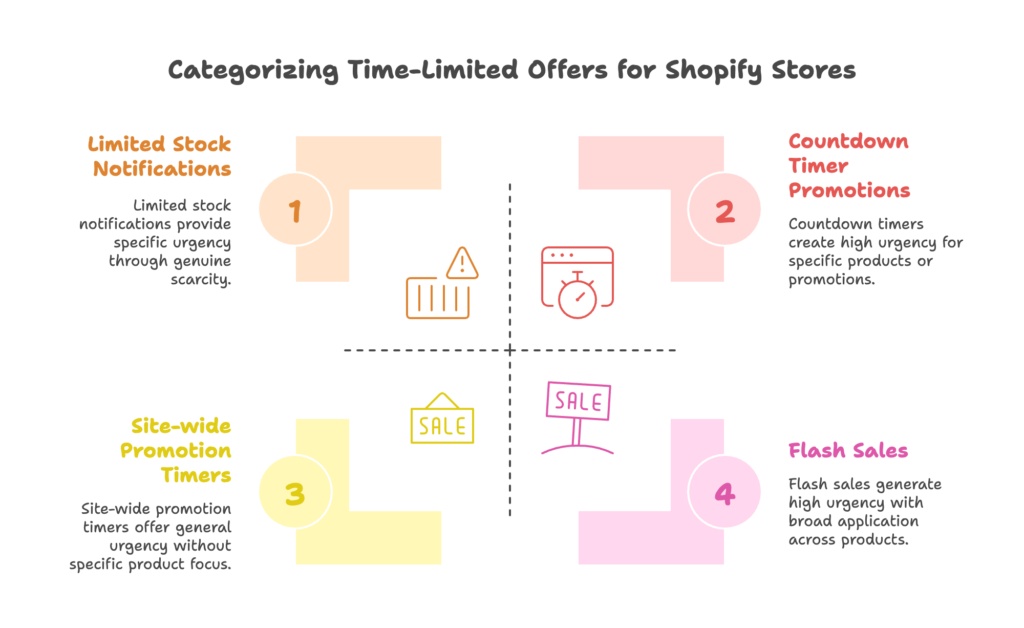
Your Shopify store has numerous opportunities to create authentic urgency that drives conversions without sacrificing trust.
Countdown Timer Promotions
Perhaps the most visual representation of urgency, countdown timers create a literal ticking clock that transforms abstract time pressure into a concrete, observable experience. Every second that passes is a second closer to a lost opportunity.
The beauty of countdown timers lies in their versatility. You can implement them in various ways depending on your specific goals:
- Product-specific timers create urgency for individual items, perfect for limited-edition releases or products with genuinely limited stock
- Site-wide promotion timers broadcast universal offers like holiday sales or seasonal discounts, creating store-wide urgency
- Abandonment recovery timers add urgency to emails sent to shoppers who’ve left items in their cart, giving them a compelling reason to return and complete the purchase
Placement is everything with countdown timers. For maximum impact, position them where they’ll be noticed without disrupting the shopping experience. Strategic locations include:
- Prominently in your homepage banner
- Adjacent to call-to-action buttons
- Just above product pricing information
- Within the shopping cart interface
Tools like Growth Suite take this a step further by creating personalized countdown timers that adapt based on user behavior. Rather than a one-size-fits-all approach, these intelligent timers display different offers and durations based on individual shopping patterns, significantly increasing their effectiveness.
Flash Sales and Limited-Window Promotions
Flash sales create intense urgency through brief, time-limited discount windows. Unlike standard promotions that might run for weeks, flash sales typically last hours or days, creating a “blink and you’ll miss it” opportunity that drives immediate action.
Creating effective flash sales requires strategic planning:
First, determine your discount structure. Research shows that percentage-based discounts (30% off) typically outperform fixed-amount discounts ($30 off) even when the mathematical value is identical, simply because percentages are easier to process. However, for high-ticket items, fixed amounts can sometimes appear more substantial.
Next, set your time window carefully. Too short, and customers won’t have time to act; too long, and the urgency dissipates. For most Shopify stores, 24-72 hours represents the sweet spot—long enough for word to spread but short enough to maintain excitement.
Product selection for flash sales is critical. The most effective approach is targeting items with:
- High visibility or recognition
- Strong margins that can absorb discounts
- Potential for add-on purchases
- Seasonal relevance or trending interest
Promotion is where many Shopify stores fall short with flash sales. For maximum impact, create a coordinated multi-channel announcement strategy:
- Email subscribers at least 24 hours before the sale begins
- Schedule social media posts to build anticipation
- Update your website homepage with a countdown to the sale
- Send push notifications when the sale goes live
With Growth Suite’s campaign engine, you can automate much of this promotional strategy, ensuring coordinated messaging across channels and maximizing visibility for your limited-time offers.
Limited Stock Notifications
Nothing creates urgency quite like genuine scarcity. Limited stock notifications leverage the powerful psychological principle that we value what’s rare and fear missing out on opportunities that won’t return.
Effective implementation approaches include:
- Real-time inventory displays that show exactly how many items remain
- “Only X left” messaging that appears when stock drops below a threshold
- Low stock alerts for items customers have viewed or saved
The key difference between effective scarcity marketing and manipulative tactics is authenticity. Your inventory displays must reflect actual stock levels—customers who discover that an “Only 2 left!” product is still available weeks later will lose trust in your brand entirely.
Consider these best practices for authentic scarcity messaging:
- Only display stock notifications when inventory genuinely falls below a threshold
- If you restock popular items, communicate this clearly
- Use scarcity messaging selectively—reserve it for products where limited availability is a reality
Advanced tools like Growth Suite help maintain this authenticity by automatically updating scarcity notifications based on real-time inventory data, ensuring your urgency messaging always reflects reality.
Implementing Urgency Features on Shopify
Now that we understand the psychology and types of urgency tactics, let’s explore how to actually implement them on your Shopify store. The good news? Shopify’s ecosystem offers multiple approaches, from built-in features to specialized apps and custom development.
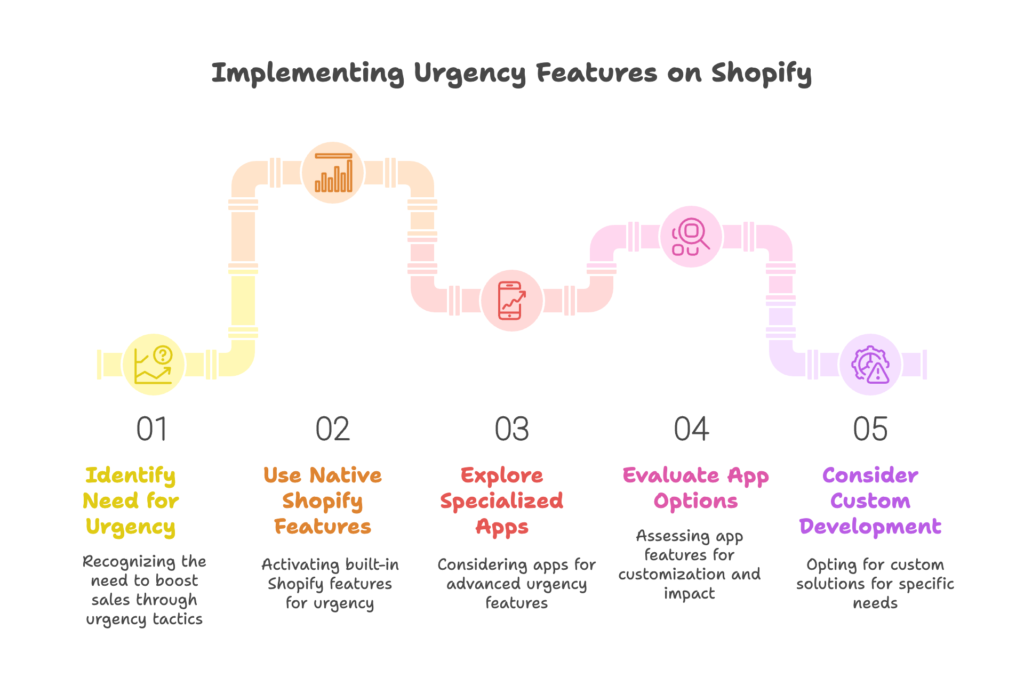
Native Shopify Capabilities
Before exploring third-party solutions, don’t overlook Shopify’s built-in capabilities for creating urgency:
Most Shopify themes include basic countdown functionality for sale items. To activate this feature:
- Navigate to your Shopify admin panel
- Select “Products” then choose the item you want to create urgency for
- In the “Pricing” section, check “This product is on sale”
- Set your sale price and, critically, the sale end date
- Save your changes
Depending on your theme, this will automatically display a countdown timer or “Sale ends on [date]” messaging on your product pages. While basic, this native functionality works well for straightforward sales and doesn’t require additional apps.
Shopify also offers inventory display options that can create scarcity-based urgency:
- Go to your Shopify admin
- Select “Settings” then “Checkout”
- In the “Order processing” section, find “Show quantity remaining”
- Set your threshold (e.g., show quantity when less than 10 remain)
- Save your changes
This setting will automatically display “Only X left!” messaging when inventory drops below your specified threshold. While you can’t customize the exact wording or appearance with native functions, it provides a simple starting point for scarcity messaging.
The limitations of native functionality become apparent for more sophisticated urgency tactics. For countdown timers that persist across sessions, personalized offers, or advanced scarcity messaging, you’ll need to explore dedicated apps or custom solutions.
Specialized Shopify Apps for Urgency Creation
The Shopify App Store offers numerous specialized tools for creating more sophisticated urgency experiences. These range from simple countdown timers to comprehensive urgency platforms.
For countdown functionality, Growth Suite stands out by offering intelligent, personalized time-limited offers. Unlike static timers that show the same countdown to every visitor, Growth Suite analyzes visitor behavior and creates tailored urgency experiences. For example:
- First-time visitors might receive a welcome discount with a 24-hour timer
- Returning visitors who’ve previously abandoned carts might see a more aggressive offer with a shorter countdown
- Visitors showing high purchase intent receive timely incentives to complete their transaction
This personalized approach typically generates conversion rates 2-3 times higher than generic timers because the urgency feels relevant rather than arbitrary.
Other popular options include Appikon Countdown Timer, which offers customizable timer designs and placement options, though without the behavior-based personalization that makes Growth Suite particularly effective.
For social proof and scarcity, consider apps like Sales Pop, which displays recent purchase notifications (“Jane from California just purchased this item 5 minutes ago”), creating both social validation and the impression of active demand.
When selecting urgency apps, evaluate them based on:
- Customization options for brand consistency
- Mobile responsiveness
- Impact on page load speed
- Integration with your existing tech stack
- Pricing structure relative to your budget
The ideal solution balances functionality with simplicity, creating effective urgency without overwhelming your customers or complicating your store management.
Custom Development Options
For Shopify Plus merchants or stores with specific requirements, custom development offers unlimited flexibility in creating urgency experiences.
Advanced timer implementations might include:
- Visitor-specific countdowns that start when a user first visits and persist across multiple sessions
- Dynamic timers that adjust based on user behavior, showing different durations to different segments
- Intelligent urgency that activates only when visitors show purchase intent, avoiding premature pressure
Personalized urgency experiences might include:
- Behavior-triggered offers that activate after specific actions (e.g., viewing multiple products in the same category)
- Customer segment-specific messaging (e.g., different urgency tactics for first-time vs. returning customers)
- Integration with customer data platforms for hyper-personalized urgency based on purchase history and preferences
Custom development typically requires working with Shopify experts or agencies, with costs ranging from hundreds to thousands of dollars depending on complexity. While this represents a higher initial investment, the conversion benefits often justify the expense for high-volume stores.
For most Shopify merchants, however, specialized apps like Growth Suite offer the ideal middle ground—more sophisticated than native functionality but without the cost and complexity of custom development.
Designing Effective Time-Limited Offer Campaigns
With the technical implementation covered, let’s focus on designing campaigns that convert. The most effective time-limited offers combine compelling structure with attention-grabbing visuals and persuasive messaging.
Offer Structure Development
The foundation of any successful urgency campaign is a well-structured offer that creates genuine value while driving immediate action.
When developing your discount strategy, consider these options:
Percentage-based discounts (30% off) work well for most products, especially those under $100. They’re instantly comprehensible and feel substantial. Research shows that percentages ending in 5 or 0 (e.g., 25%, 40%) are perceived as more significant than other numbers, even when the actual difference is minimal.
Fixed amount discounts ($30 off) become more effective for higher-priced items where the absolute savings feels substantial. They work particularly well when the fixed amount is a round number ($50 off rather than $47 off).
Tiered offers create ascending value based on purchase amount:
- Spend $50, save 10%
- Spend $100, save 15%
- Spend $150, save 20%
This approach not only creates urgency but also increases average order value as customers “level up” to higher discount tiers.
Free shipping thresholds with deadlines combine two powerful motivators—free shipping and time pressure. “Free shipping on all orders over $50 ends tonight!” consistently drives both conversions and larger cart sizes.
Time window optimization is equally crucial. Consider these factors when determining your promotion duration:
- Customer decision cycle: Higher-priced items typically require longer consideration periods
- Product complexity: Technical or specialized products may need longer windows for customers to research
- Audience characteristics: B2B customers often need more time than B2C customers
For most consumer products, 24-72 hours represents the sweet spot—long enough for customers to act but short enough to maintain urgency.
Day-of-week and time-of-day also impact campaign performance. Data from Growth Suite shows that urgency campaigns launched on Tuesdays and Wednesdays typically outperform those launched on weekends, while campaigns ending on Sunday evening often see the highest last-minute conversion spikes.
Seasonal timing adds another layer of strategy. Urgency campaigns are particularly effective during:
- Traditional shopping periods (Black Friday, Christmas)
- Industry-specific windows (Back-to-school for educational products)
- Changing seasons (Winter clearance, Summer preview)
The ideal campaign combines these elements into a coherent offer with a clear value proposition and genuine time limitation.
Visual Design Elements
Even the most compelling offer will underperform if it’s not visually striking. Effective urgency design captures attention without disrupting the shopping experience.
Color psychology plays a significant role in urgency creation:
- Red creates the highest sense of urgency and has been shown to increase conversion rates by up to 21% when used for limited-time offers
- Orange combines urgency with friendliness, making it ideal for creating pressure without appearing aggressive
- Yellow captures attention while maintaining a positive emotional tone
Strategic contrast matters more than the specific color—your urgency elements should stand out clearly from your regular site design while maintaining brand consistency.
Animation and movement draw the eye naturally. Consider these options:
- Ticking countdown timers with animated seconds
- Subtle pulsing effects around urgency messaging
- Gentle movement that doesn’t distract from the overall shopping experience
Mobile responsiveness is non-negotiable for urgency elements. With over 70% of Shopify traffic coming from mobile devices, your urgency displays must be:
- Clearly visible on small screens
- Touch-friendly for mobile users
- Properly sized to avoid overwhelming the mobile interface
- Positioned to avoid interfering with critical shopping functions
Growth Suite excels in this area, with mobile-first urgency designs that adapt intelligently to different screen sizes and device types.
Messaging and copy development completes the urgency equation. The most effective urgency copy is:
- Clear and specific: “Sale ends Monday at midnight” rather than “Limited time offer”
- Benefit-focused: Emphasize what customers gain, not just what they save
- Action-oriented: Use command verbs like “Shop,” “Save,” “Grab,” and “Secure”
Avoid pressure-heavy wording that feels manipulative. “Don’t miss out!” creates urgency; “You’ll regret it forever if you don’t buy now!” creates suspicion. The former motivates; the latter alienates.
Combine these visual and copy elements into a cohesive design that creates urgency while enhancing, not detracting from, the overall shopping experience.
Measuring and Optimizing Time-Limited Offer Performance
Creating urgency is just the beginning. To truly maximize its impact, you need to measure performance, analyze results, and continuously optimize your approach.
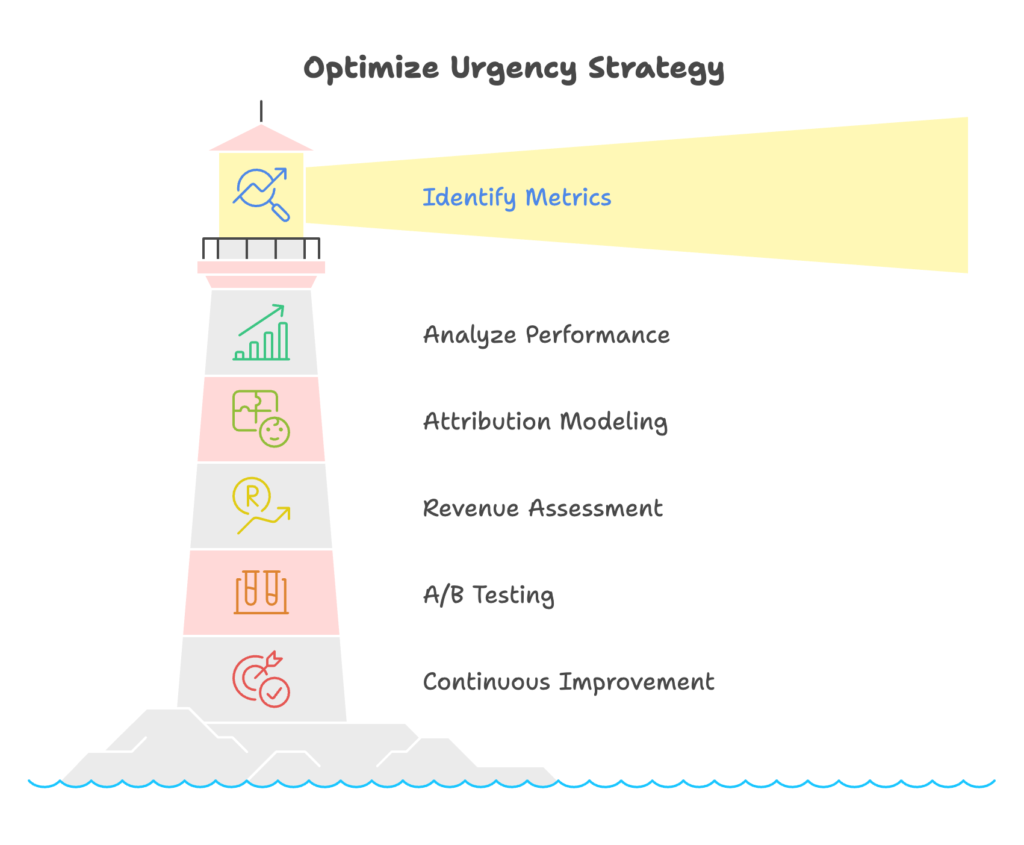
Key Performance Metrics
Effective measurement starts with identifying the right metrics to track. While sales volume might seem like the obvious indicator, several other metrics provide deeper insights into urgency effectiveness:
Conversion rate is your primary success indicator. Compare your baseline conversion rate (without urgency elements) to your during-promotion rate to quantify the direct impact of your urgency tactics. Segment this analysis by:
- Traffic source (do social visitors respond differently than email subscribers?)
- Device type (is urgency more effective on mobile or desktop?)
- Customer type (new vs. returning visitors)
- Time of day (when do your urgency tactics perform best?)
This segmented analysis often reveals surprising insights—perhaps urgency works exceptionally well for mobile visitors from Instagram but underperforms for desktop visitors from Google.
Attribution modeling helps determine which urgency elements drive conversions. Did customers convert after seeing:
- Homepage countdown timers?
- Product page scarcity messaging?
- Cart abandonment recovery emails with limited-time offers?
Understanding which touchpoints create the most urgency allows you to double down on your most effective tactics.
Revenue impact assessment looks beyond simple conversion rates to understand broader financial implications:
- Average order value (AOV): Do urgency tactics increase order size?
- Profit margin: How do discounts affect your overall profitability?
- Customer acquisition cost (CAC): Does urgency reduce the cost of converting new customers?
The most valuable metric may be customer lifetime value (CLV) impact. Do customers acquired through urgency tactics become loyal shoppers, or do they only purchase during promotions? The answer determines whether your urgency strategy builds sustainable growth or trains customers to wait for discounts.
Tools like Growth Suite provide comprehensive analytics dashboards that track these metrics automatically, giving you clear visibility into the performance of your urgency campaigns without manual data collection.
Testing and Optimization Strategies
With your metrics established, continuous testing becomes the path to improvement. A/B testing allows you to compare different approaches and identify the most effective strategies for your specific audience.
Timer design and placement testing might compare:
- Different visual styles (minimalist vs. attention-grabbing)
- Various placements (top banner vs. next to product images)
- Color schemes (red timers vs. branded colors)
Offer duration experimentation might test:
- 24-hour flash sales vs. 72-hour promotions
- Sales that end at midnight vs. those that end during business hours
- Weekday promotions vs. weekend offers
Messaging variation testing could compare:
- “Limited time” vs. exact end dates (“Ends Sunday”)
- Loss-focused copy (“Don’t miss out”) vs. gain-focused copy (“Secure your discount”)
- Specific vs. general urgency language
For meaningful results, change only one variable at a time and ensure sufficient traffic for statistical significance. Most tests require at least several hundred conversions to provide reliable insights.
Building a continuous improvement framework transforms these individual tests into systematic optimization:
- Establish baseline metrics before implementing urgency tactics
- Implement changes one at a time to isolate their impact
- Collect data over sufficient time periods (typically 1-2 weeks minimum)
- Analyze results against your key metrics
- Implement improvements based on data, not assumptions
- Repeat the process continuously
This iterative approach leads to urgency tactics that are precisely calibrated to your specific audience and products, significantly outperforming generic best practices.
Avoiding Common Pitfalls and Ethical Considerations
Urgency is powerful, but with great power comes great responsibility. The most successful Shopify merchants understand that short-term conversion boosts aren’t worth long-term brand damage.
Maintaining Brand Integrity
The fundamental challenge is balancing urgency with trust. Pressure tactics might drive immediate sales but can erode the customer relationship over time.
Ensuring authentic time limitations is non-negotiable. This means:
- When your countdown ends, the offer genuinely expires
- Limited stock warnings reflect actual inventory levels
- “Last chance” truly means last chance—the same offer doesn’t return next week
Some Shopify stores make the mistake of perpetual urgency—endless “final hours” that never actually end. While this might fool first-time visitors, returning customers quickly recognize the manipulation, damaging trust irreparably.
Delivering on promotional promises extends beyond the urgency itself. If you promise next-day shipping during a flash sale, ensure your fulfillment can handle the increased volume. Nothing damages credibility faster than failing to deliver on time-sensitive promises.
Avoiding “false urgency” tactics that damage credibility means steering clear of:
- Countdown timers that reset when they reach zero
- Limited stock notifications for products with plentiful inventory
- “One-time-only” offers that appear repeatedly
- Artificial purchase notifications (“Someone in [nearby city] just bought this!”)
Customer experience considerations should always take precedence over conversion optimization. Ask yourself:
- Does this urgency tactic enhance or detract from the shopping experience?
- Would I feel manipulated if I encountered this as a customer?
- Does this align with my brand values and voice?
Post-promotion satisfaction strategies are equally important. Consider how customers will feel after responding to your urgency. Will they:
- Feel satisfied with their purchase decision?
- Recommend your store to others?
- Return for future purchases, even without urgency?
The ideal urgency tactic creates satisfaction, not regret. Growth Suite helps maintain this balance by creating personalized, authentic urgency that feels helpful rather than manipulative, preserving brand integrity while driving conversions.
Compliance and Best Practices
Beyond ethical considerations, legal compliance is essential for urgency tactics. Promotional disclosure requirements vary by country but generally require:
- Clear communication of all offer terms and conditions
- Transparent display of regular prices alongside sale prices
- Accurate representation of discounts and savings
In the United States, the Federal Trade Commission (FTC) specifically prohibits creating false impressions of scarcity or urgency. Similar regulations exist in the EU, UK, Canada, and Australia.
Pricing representation regulations require that sale prices represent genuine discounts from established regular prices. You can’t artificially inflate prices immediately before a sale to create the appearance of deeper discounts.
Terms and conditions for time-limited offers should be clearly accessible to customers before purchase. These should specify:
- Exact promotion duration (including time zone)
- Any exclusions or limitations
- How the discount applies to returned items
- Whether the offer can be combined with other promotions
Industry standards for urgency tactics have evolved to favor transparency and authenticity. Best practices include:
- Showing exact end dates and times rather than vague “limited time” messages
- Providing genuine stock levels rather than arbitrary “low stock” warnings
- Ensuring all urgency messaging is consistent across channels
Consumer protection considerations should inform every urgency decision. The most effective tactics create win-win scenarios where customers genuinely benefit from acting quickly while your store increases conversions.
Advanced Strategies for Shopify Experts
For experienced Shopify merchants looking to take urgency to the next level, advanced personalization and multi-channel coordination offer powerful opportunities to maximize impact.
Personalized Urgency Tactics
Generic urgency tells customers “This offer is limited.” Personalized urgency tells them “This offer is limited and specifically relevant to you.” The difference in conversion impact can be dramatic.
Customer segment-specific approaches might include:
For first-time visitors, welcome-focused urgency emphasizes incentives to begin the relationship:
- “New customer exclusive: 15% off your first order ends in [countdown]”
- Email sign-up incentives with limited availability
- First-purchase guarantees with time limitations
For returning customers who haven’t purchased, recognition-based urgency acknowledges their previous interest:
- “We saved your items! Complete your purchase in [countdown] to secure your discount”
- Personalized recommendations with time-limited offers
- Loyalty program invitations with deadline-driven bonuses
For previous customers, loyalty-focused urgency rewards their relationship with your brand:
- “Exclusive for returning customers: Your VIP discount expires in [countdown]”
- Early access to new products with limited availability
- Anniversary or birthday promotions with definite end dates
Behavioral trigger implementation takes personalization further by activating urgency based on specific customer actions:
- Browse behavior-based offers might show time-limited discounts after a customer views multiple products in the same category
- Time-on-site triggered promotions could display escalating offers based on engagement duration
- Product interest-based urgency might highlight limited stock for items a customer has viewed repeatedly
Growth Suite excels in this area, with AI-driven analysis that identifies optimal moments to introduce personalized urgency based on individual customer behavior patterns, significantly increasing conversion rates compared to generic approaches.
Multi-Channel Urgency Coordination
The most sophisticated urgency strategies extend beyond your Shopify store to create a coordinated experience across all customer touchpoints.
Email marketing integration might include:
- Countdown timers within emails that update dynamically when opened
- Abandoned cart email sequences with escalating urgency (first email offers gentle reminder, follow-ups introduce time-limited incentives)
- Post-click consistency ensuring that landing pages maintain the same urgency messaging from emails
Social media and advertising alignment creates urgency before customers even reach your store:
- Ad messaging with urgency elements (“Last day!” overlays on product images)
- Platform-specific urgency techniques (Instagram Stories countdowns, Facebook Event-tied promotions)
- Retargeting campaigns that introduce urgency to users who’ve previously viewed products
The key to multi-channel urgency is consistency. A customer who sees “24 hours left!” on Instagram should see the same message on your website, in emails, and in any other touchpoints—different deadlines across channels create confusion rather than urgency.
Advanced tools like Growth Suite facilitate this coordination by centralizing urgency campaign management, ensuring consistent messaging across channels while still allowing for personalization based on individual customer behavior.
References
- Shopify Blog. (2024). Best Limited-Time Offer Ideas to Drive More Ecommerce Sales. https://www.shopify.com/blog/limited-time-offer
- Amai. (n.d.). How to Use a Shopify Urgency App for Increased Sales. https://amai.com/leverage-urgency-increase-sales-shopify/
- MarketingLib. (2025). Shopify Time Limited Offer Guide. https://marketinglib.com/shopify-time-limited-offer-guide/
- Praella. (2024). Effective Shopify Cart Urgency Tactics to Boost Sales. https://praella.com/blogs/shopify-insights/effective-shopify-cart-urgency-tactics-to-boost-sales
Ready to supercharge your Shopify store’s sales with perfectly optimized time-limited offers? Growth Suite helps you create intelligent, personalized urgency campaigns that drive conversions while maintaining customer trust. With AI-powered discount codes, countdown timers, and inventory alerts, Growth Suite makes it easy to implement all the strategies discussed in this article. Install the app with a single click and start turning browsers into buyers today!
Don’t forget to check these articles;
